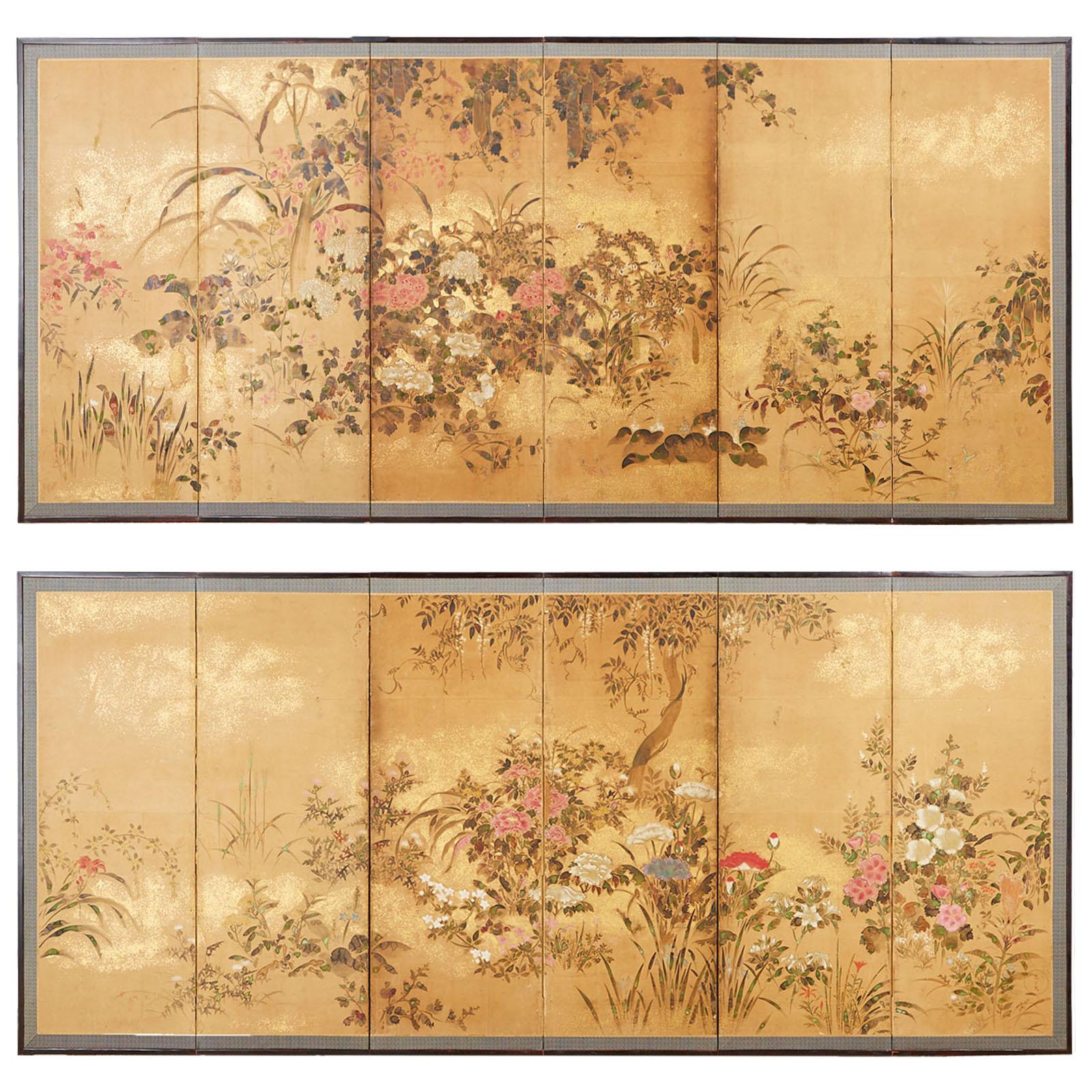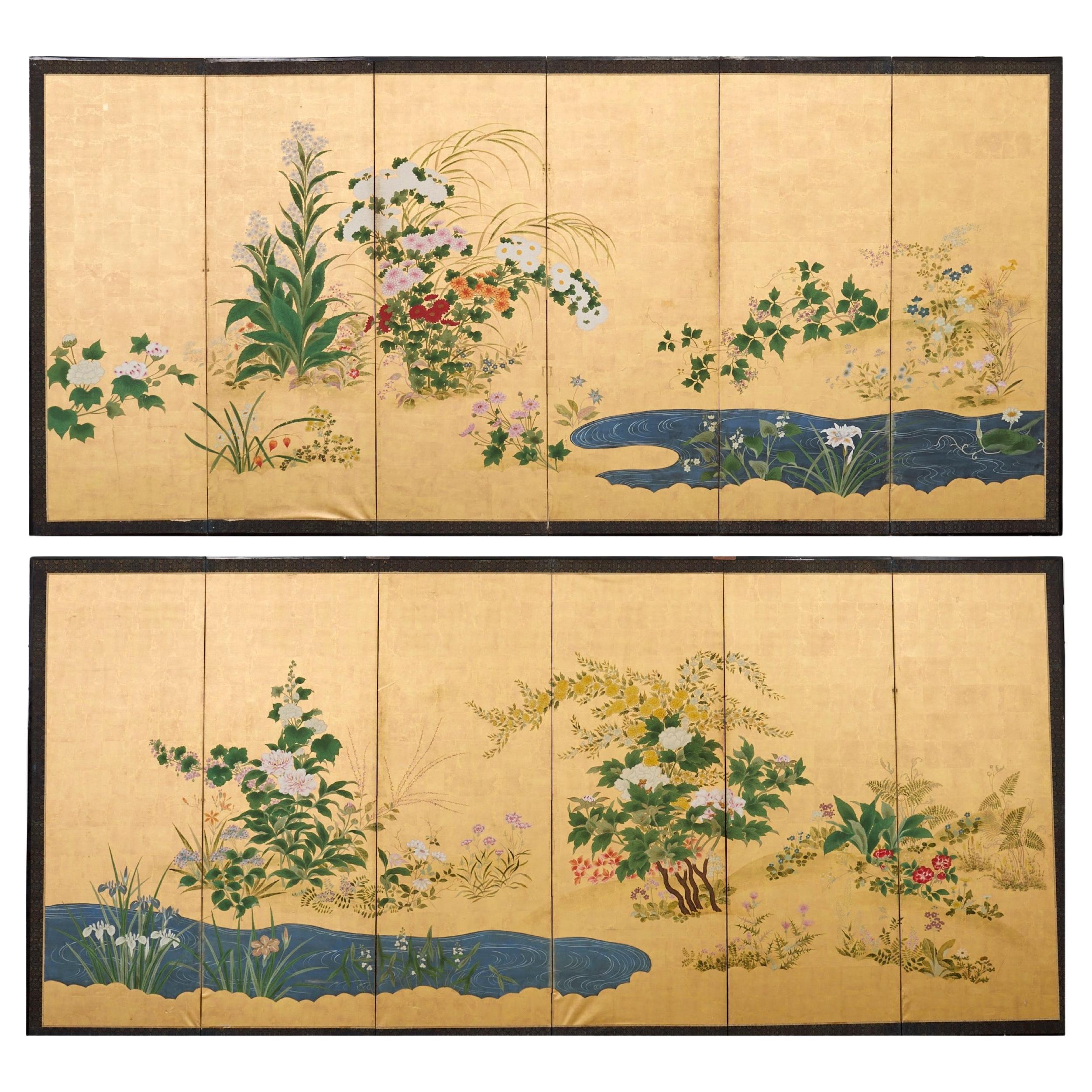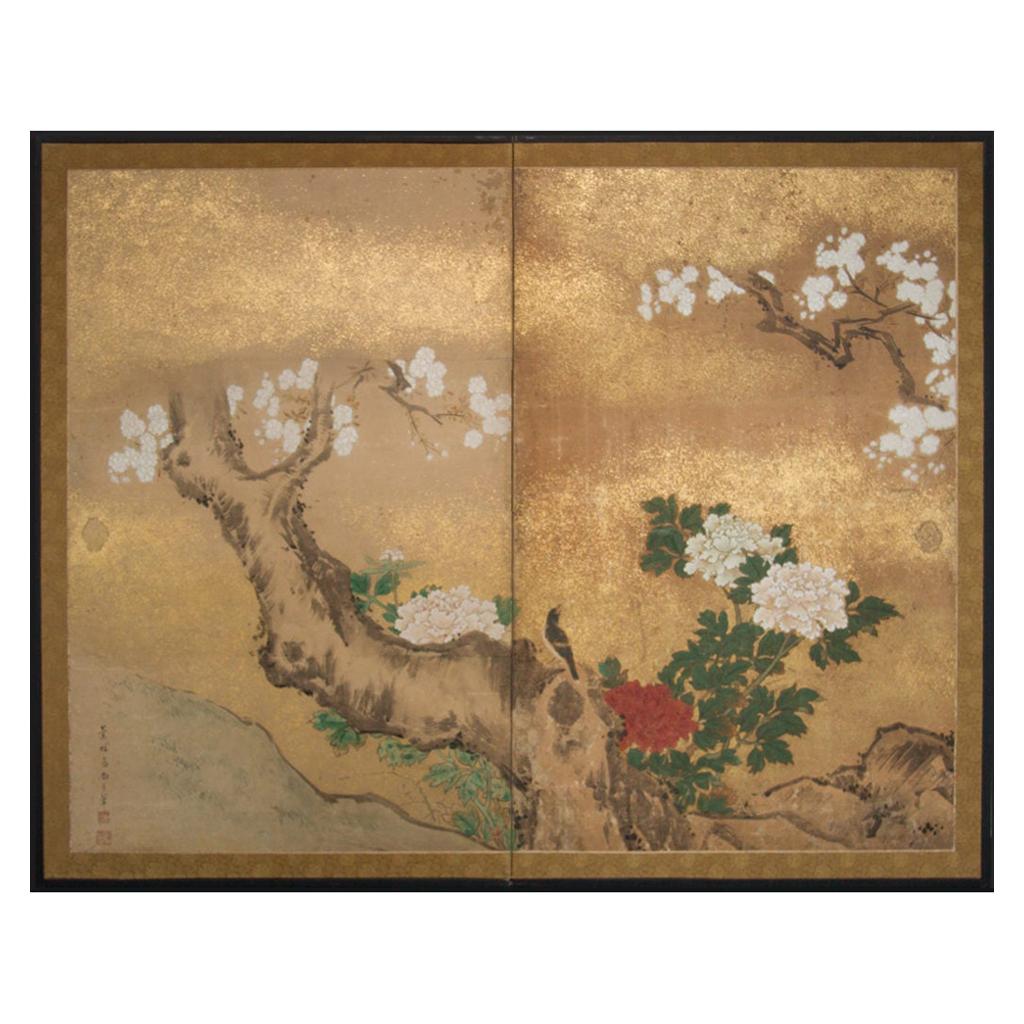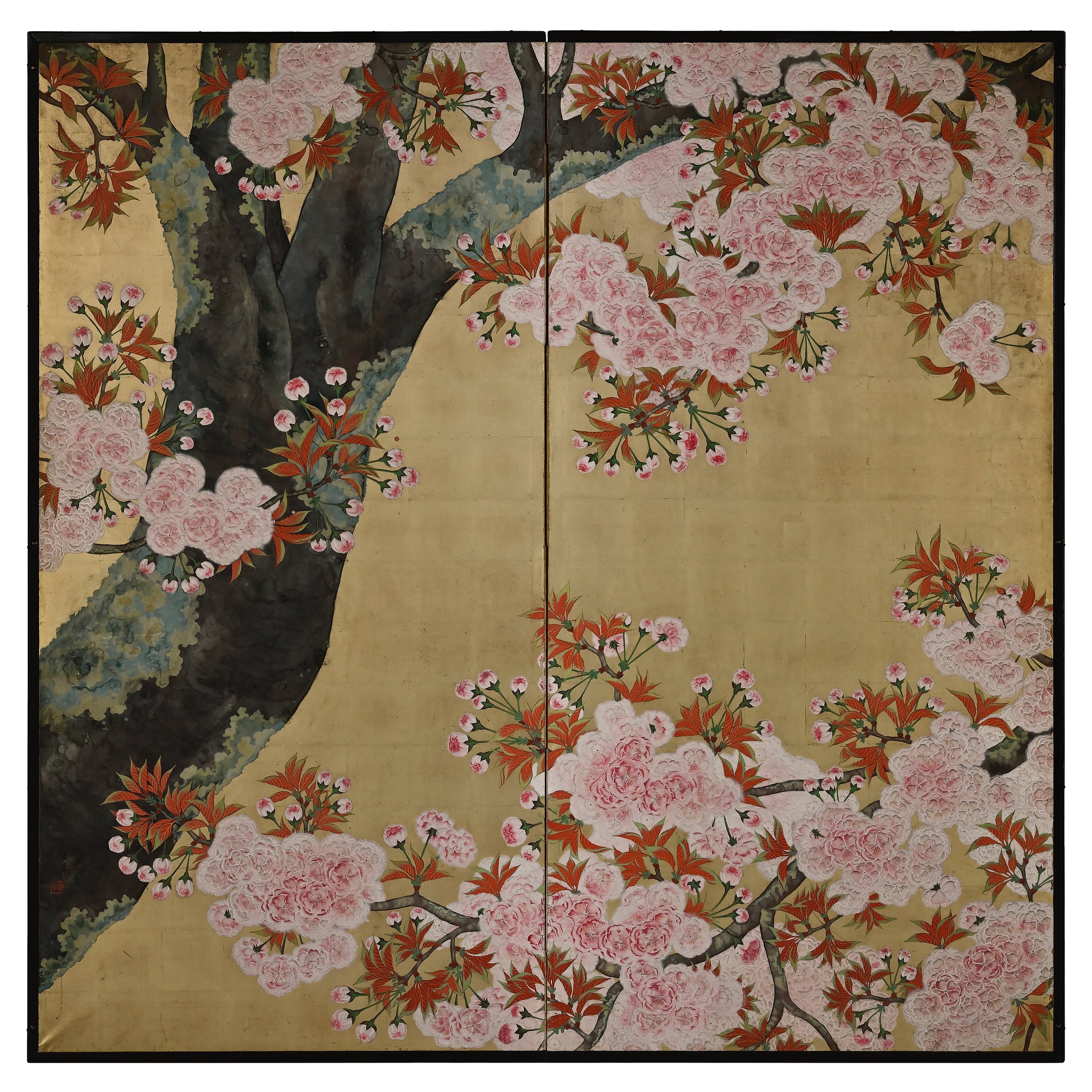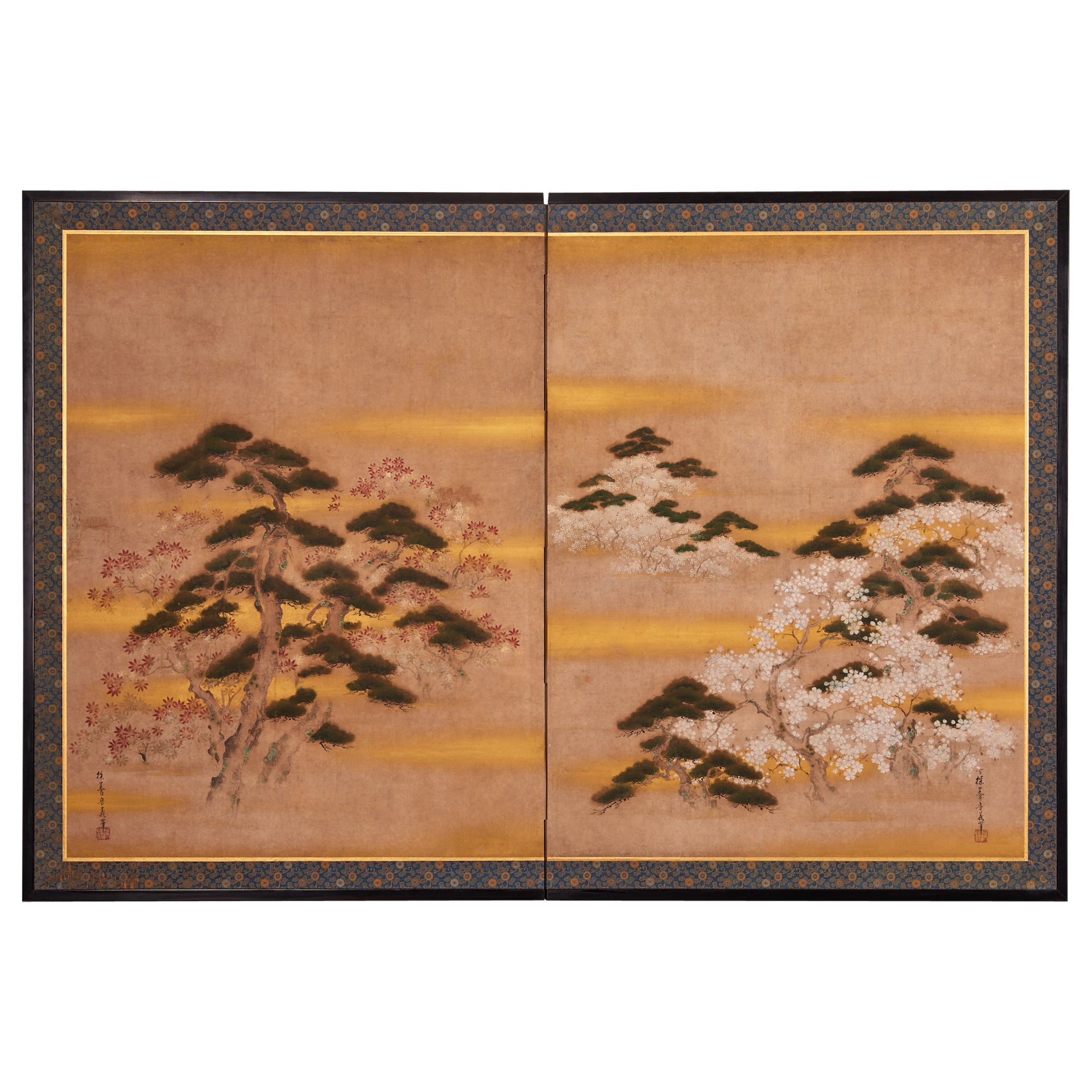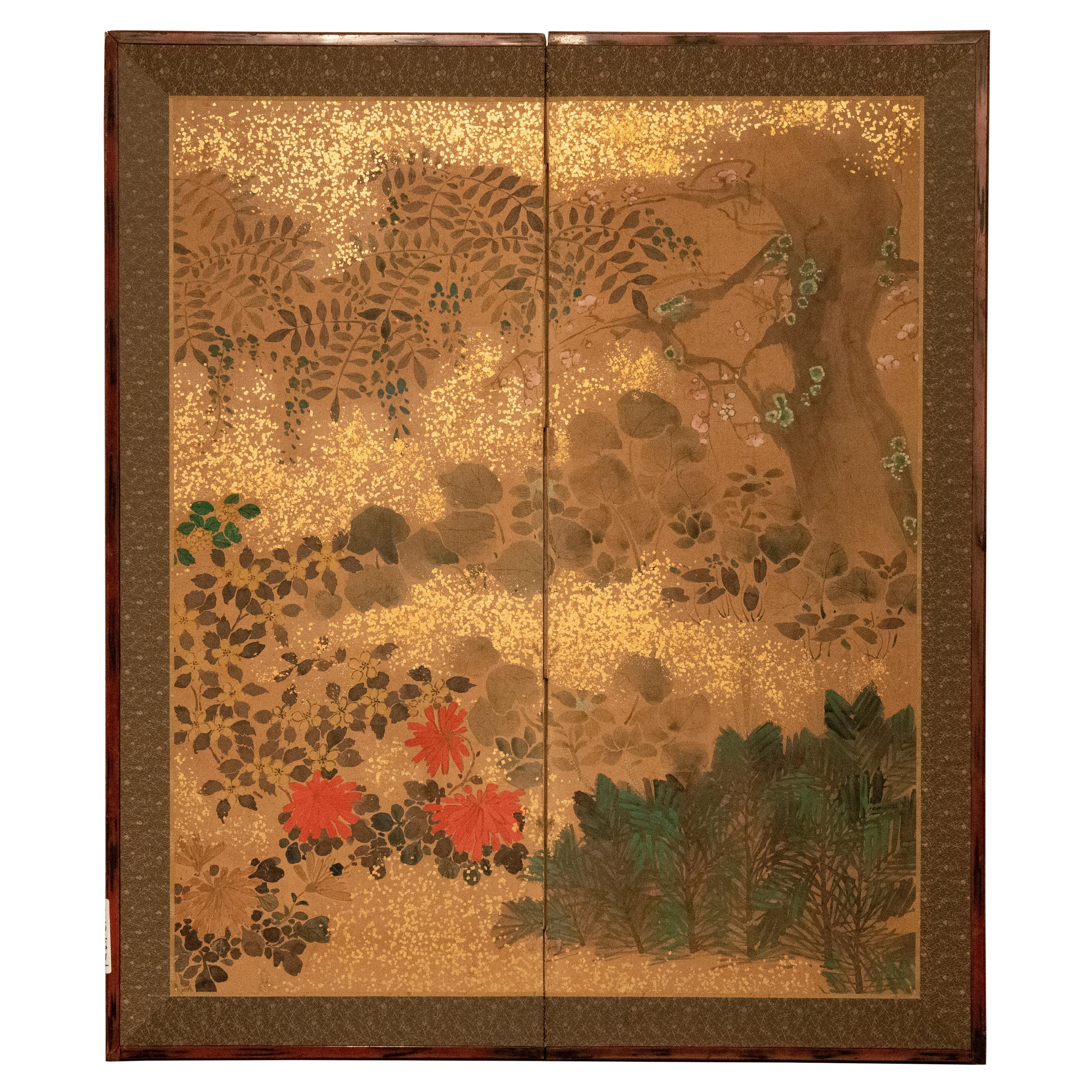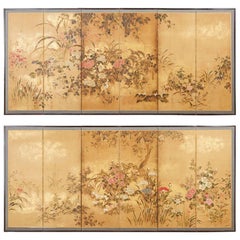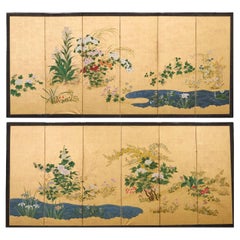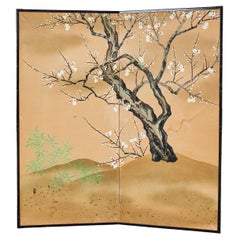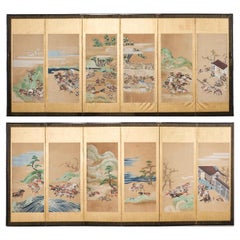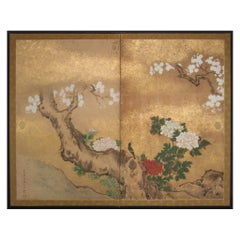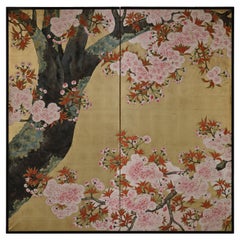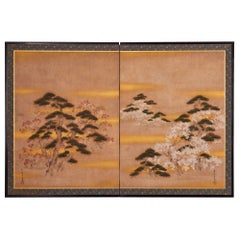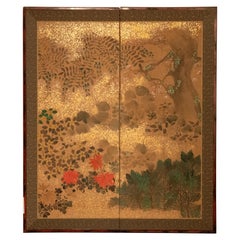Items Similar to Pair of Red and White Plum Blossom Screens After Ogata Korin
Video Loading
Want more images or videos?
Request additional images or videos from the seller
1 of 22
Pair of Red and White Plum Blossom Screens After Ogata Korin
$8,000per set
£6,116.43per set
€7,044.89per set
CA$11,210.45per set
A$12,515.42per set
CHF 6,557.89per set
MX$153,200.98per set
NOK 83,285.27per set
SEK 78,527.43per set
DKK 52,576.72per set
Shipping
Retrieving quote...The 1stDibs Promise:
Authenticity Guarantee,
Money-Back Guarantee,
24-Hour Cancellation
About the Item
Amazing pair of 18th century Edo period style paintings of red and white plum blossoms after Ogata Korin (Japanese 1658-1716). One of the most famous paintings in Japan where it is registered as a national treasure. The screens were painted by a famous 20th century artist "Shoraku" with a signature and seal on each painting. The stylized spring screens depict flowing water in serpentine shapes with plum blossoms on each side. The painting is crafted from ink and natural color pigments over a dramatic gold leaf square background. The painting is considered Rimpa school. Very good condition, well preserved screens. From an estate in San Francisco, California.
- Dimensions:Height: 35.5 in (90.17 cm)Width: 49.5 in (125.73 cm)Depth: 0.75 in (1.91 cm)
- Sold As:Set of 2
- Style:Edo (In the Style Of)
- Materials and Techniques:
- Place of Origin:
- Period:
- Date of Manufacture:20th Century
- Condition:Wear consistent with age and use. Beautifully crafted with solid joinery and construction. Very good, well preserved condition as seen in photos. Age appropriate wear and fading. Minor chips and scuffs on frame. Reverse side has small paper losses.
- Seller Location:Rio Vista, CA
- Reference Number:1stDibs: LU1555245421512

About the Seller
5.0
Erin Lane Estate is based in the San Francisco Bay Area, and its team of furniture restorers, art curators, professional appraisers and Asia specialists sources prime vintage and antique furniture from the finest estates in Northern and Southern California. Erin Lane Estate specializes in Hollywood Regency, McGuire, Chinese and Japanese pieces.
Diamond Seller
Premium sellers with a 4.7+ rating and 24-hour response times
Established in 2000
1stDibs seller since 2015
3,012 sales on 1stDibs
Typical response time: 1 hour
- ShippingRetrieving quote...Shipping from: Rio Vista, CA
- Return Policy
Authenticity Guarantee
In the unlikely event there’s an issue with an item’s authenticity, contact us within 1 year for a full refund. DetailsMoney-Back Guarantee
If your item is not as described, is damaged in transit, or does not arrive, contact us within 7 days for a full refund. Details24-Hour Cancellation
You have a 24-hour grace period in which to reconsider your purchase, with no questions asked.Vetted Professional Sellers
Our world-class sellers must adhere to strict standards for service and quality, maintaining the integrity of our listings.Price-Match Guarantee
If you find that a seller listed the same item for a lower price elsewhere, we’ll match it.Trusted Global Delivery
Our best-in-class carrier network provides specialized shipping options worldwide, including custom delivery.More From This Seller
View AllPair of Japanese Edo Rimpa School Screens after Tawaraya Sōtatsu
Located in Rio Vista, CA
Impressive pair of 17th century Japanese Edo period Rinpa school screens made in the manner and style of Autumn Grasses by Tawaraya Sōtatsu (1570-1640). Beautifully decorated with wi...
Category
Antique 17th Century Japanese Edo Paintings and Screens
Materials
Gold Leaf
Pair of Japanese Meiji Screens Blossoms of Spring, Summer and Autumn
Located in Rio Vista, CA
Amazing pair of late 19th/early 20th century Japanese Meiji period byobu screens depicting flowering plants and blossoms of the spring, summer, and autumn. Painted in the Nihonga sch...
Category
Antique 19th Century Japanese Meiji Paintings and Screens
Materials
Brass, Gold Leaf
Japanese Showa Two Panel Screen Blossoming Prunus Tree
Located in Rio Vista, CA
Serene Japanese Showa period two-panel folding byobu screen depicting a large spring blossoming prunus tree or plum tree. Beautifully painted with ink and natural color pigments on m...
Category
20th Century Japanese Showa Paintings and Screens
Materials
Brass
Pair of Japanese Edo/Tokugawa Screens Tale of Heiki
Located in Rio Vista, CA
Monumental pair of late 18th century Japanese Edo/Tokugawa period byobu screens depicting the battles between Taira and Minamoto. The screens have six panels each with individual sce...
Category
Antique 19th Century Japanese Edo Paintings and Screens
Materials
Brass, Gold Leaf
Pair of Japanese Taisho Period Screens Paragons of Filial Piety
Located in Rio Vista, CA
Impressive pair of Japanese screens from the Taisho period meiji. Each six-panel screen depicts an image from the 24 paragons of filial piety ...
Category
20th Century Japanese Taisho Paintings and Screens
Materials
Brass, Gold Leaf
Pair of Japanese Edo Six Panel Screens the Seven Sages
Located in Rio Vista, CA
Fantastic pair of 19th century Japanese late Edo/early Meiji period six-panel screens titled The seven sages of the bamboo grove. The Kano school screens...
Category
Antique 19th Century Japanese Edo Paintings and Screens
Materials
Brass, Gold Leaf
You May Also Like
Japanese Two-Panel Screen Peony and Cherry
Located in Hudson, NY
Japanese two-panel screen: Peony and Cherry, Edo period (circa 1800) painting, formerly fusuma (Japanese sliding doors), executed in the Kano school style, featuring a cherry tree in...
Category
Antique Early 1800s Japanese Edo Paintings and Screens
Materials
Gold Leaf
Early 20th Century Japanese Cherry Blossom Screen by Kano Sanrakuki
Located in Kyoto, JP
Cherry Blossoms
Kano Sanrakuki (1898-1981)
Showa period, circa 1930
2-panel Japanese Screen
Color, gofun and gold leaf on paper
Against a backdrop of gold-leafed ground, the lichen covered trunk and branches of the life-sized cherry blossom tree reach out and beyond the confines of the pictorial surface. The overall composition has a feeling of flatness which draws emphasis to the surface and the three-dimensionality of the cherry blossoms. Painstakingly built-up layers of thickly applied shell-white gofun detail the voluminous blossoms and cover large areas of this tour-de-force of Japanese Nihonga painting. By simplifying the background, minimizing the number of colors and depicting the blossoms with such heavy relief, the artist has emphasized the stunning presence of the cherry tree. The type of tree depicted is the Yae-Zakura; a double-layered type of cherry blossom famed for its beauty and strength. When we think of Japanese cherry blossoms, the first thing that comes to mind is Somei Yoshino variety, which has a single flower with five almost white petals. This type is fragile and easily blown away by strong wind or rain. Most of the double-flowered cherry blossoms begin to bloom when the Somei-Yoshino falls, and the flowering period lasts longer than that of the Somei-Yoshino.
Kano Sanrakuki originally studied painting at the Kyoto City Arts and Crafts School under the tutelage of Yamamoto Shunkyo...
Category
Early 20th Century Japanese Showa Paintings and Screens
Materials
Gold Leaf
Japanese Two-Panel Screen, Pine, Cherry, and Maple
Located in Hudson, NY
Cherry blossoms and maples among ragged pines. Mineral pigments on mulberry paper with gold mist clouds. Completely remounted utilizing an antique silk brocade...
Category
Antique Mid-19th Century Japanese Paintings and Screens
Materials
Gold, Bronze
Japanese Two Panel Screen: Rimpa Flowers
Located in Hudson, NY
with gold flake design. Mineral pigments on mulberry paper, with silk brocade border, and red negoro style lacquer trim.
Category
Early 20th Century Japanese Paintings and Screens
Materials
Gold
Japanese Two-Panel Screen, Floral Garden on Gold
Located in Hudson, NY
Peonies, marigolds and pinks next to a garden stone with soft mountain peaks in the background. Late Edo (1603 - 1868) period painting in mineral pigmen...
Category
Antique Early 19th Century Japanese Edo Paintings and Screens
Materials
Gold Leaf
Japanese Two Panel Screen: Flowering Vines and Wisteria
Located in Hudson, NY
Wisteria represents sentiments of love and longevity as vibrant floral colors dance dramatically amongst the two panels. Mineral pigments on Mulberry paper with a natural wood trim....
Category
Early 20th Century Japanese Paintings and Screens
Materials
Wood, Paper
More Ways To Browse
Plum Wood
18th Century Asia Brass
Pair Of Japanese Screens
Edo Screen Gold
18th Century Japanese Screens
18th Century Japanese Silk Painting
Japanese Rimpa Screens
Ogata Korin
Chinoiserie Art Panel
Japanese Screen Kyoto
Japanese Six Panel Screen
Antique Metal Screen
Tea Screen
Chinese Lacquer Tree
Japanese Showa Screen
Green Japanese Screen
Chinese Silk Brocade
Pair Of Japanese Screens
